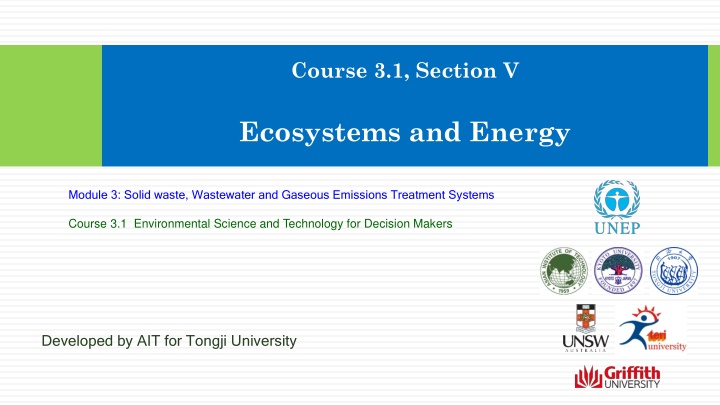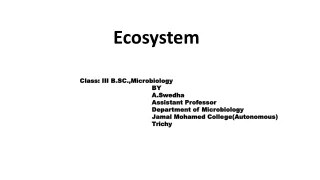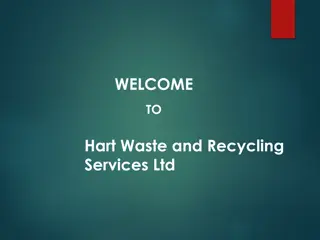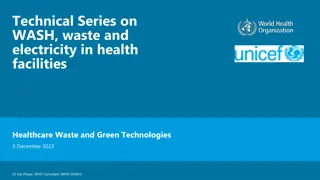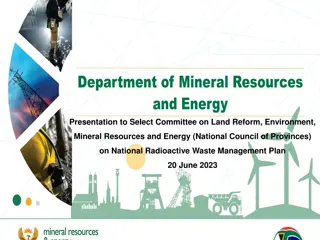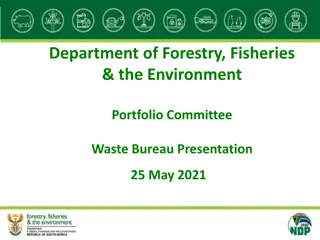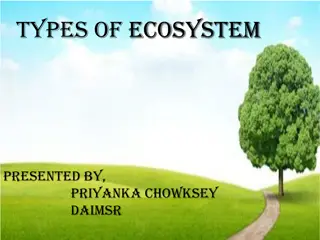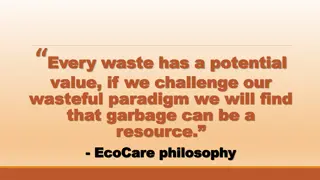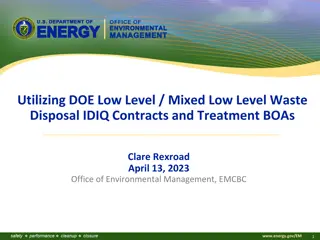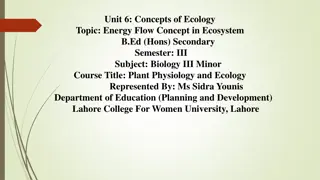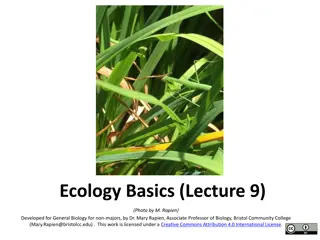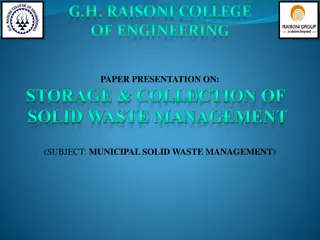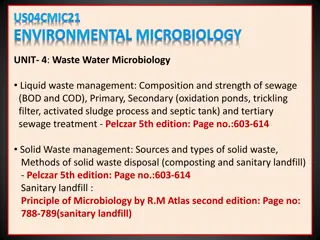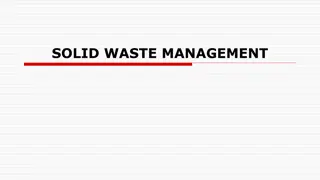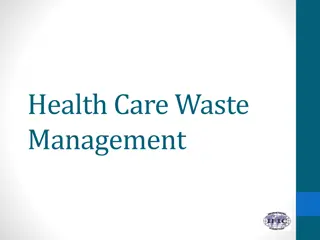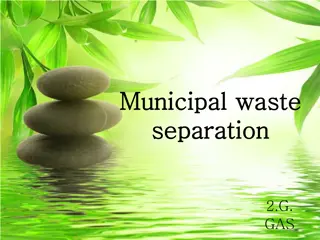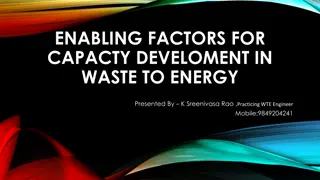Ecosystems and Energy: Waste Treatment Systems
This module covers decision-making on pollution standards, health effects, risk assessments, waste management, wastewater treatment, gaseous emissions, and the importance of setting standards to mitigate environmental pollution. It discusses the types of standards, such as flexible and rigid standards, and regulatory standards including ambient environmental quality, effluent and emission standards, technology-based standards, and others.
Uploaded on Mar 12, 2025 | 2 Views
Download Presentation

Please find below an Image/Link to download the presentation.
The content on the website is provided AS IS for your information and personal use only. It may not be sold, licensed, or shared on other websites without obtaining consent from the author.If you encounter any issues during the download, it is possible that the publisher has removed the file from their server.
You are allowed to download the files provided on this website for personal or commercial use, subject to the condition that they are used lawfully. All files are the property of their respective owners.
The content on the website is provided AS IS for your information and personal use only. It may not be sold, licensed, or shared on other websites without obtaining consent from the author.
E N D
Presentation Transcript
Course 3.1, Section V Ecosystems and Energy Module 3: Solid waste, Wastewater and Gaseous Emissions Treatment Systems Course 3.1 Environmental Science and Technology for Decision Makers Developed by AIT for Tongji University
Outline Decision Making on Pollution Standards: Ambient vs. Effluent/Emission Standards Health Effects, Risk Models and Assessments Setting Priority for Action 2 Module 3: Waste Management Treatment Systems
Standards: Why??? Why??? Medical Data Technology (BAT) Public Pressure Foreign Country Economics Case Studies If no standards, what happens??? 4 Module 3: Solid waste, Wastewater and Gaseous Emissions Treatment Systems
Standards: Emission Standards: Air Pollutant Discharge Standard: Wastewater 5 Module 3: Solid waste, Wastewater and Gaseous Emissions Treatment Systems
Standards: Type of Standard: Flexible Standard Rigid Standard 6 Module 3: Solid waste, Wastewater and Gaseous Emissions Treatment Systems
Flexible Standard Individuals make decision State or local authorities demand for certain types and degree of treatment based on the best interest of the person living near the receiving body Disadvantages Advantages Unfairness- treatment is different from one location to another Lack of representation of all the group involved in the use of the stream Freedom to make decision Non-uniformity 7 Module 3: Solid waste, Wastewater and Gaseous Emissions Treatment Systems
Types of Standard: Rigid Standard: A Fixed Standard for the Pollution Control. 8 Module 3: Solid waste, Wastewater and Gaseous Emissions Treatment Systems
Regulatory Standards: Ambient Environmental Quality Standards Effluent and Emission Standards Technology-based Standards Performance Standards Product Standards Process Standards 9 Module 3: Solid waste, Wastewater and Gaseous Emissions Treatment Systems
Ambient Environmental Quality Standard: ambient air quality standards o Establishes the highest allowable concentration of specified pollutants in the ambient air. ambient water quality standards o Establishes the highest allowable concentration of specified pollutants in the ambient water. 10 Module 3: Solid waste, Wastewater and Gaseous Emissions Treatment Systems
Standards of Stream Quality: Effluent Standards: o Effluents from industries be kept below a certain maximum concentration of polluting matter. Stream Standards: o Establish classification and standards of quality for a stream and regulate discharge into it accordingly. 11 Module 3: Solid waste, Wastewater and Gaseous Emissions Treatment Systems
Effluent Standard: Advantages: o Easier to control o Detailed stream-analysis not o Needed for determination of o Exact amount of waste treatment. Disadvantages: o Large industries pollute more than the smaller o Not good for overloaded streams o No control over total volume of polluting substance 12 Module 3: Solid waste, Wastewater and Gaseous Emissions Treatment Systems
Gradual Phasing-out of Palm Oil Effluent BOD, Malaysia 6000 5000 BOD Level, ppm 4000 2000 2000 1000 500 250 100 0 1978 1980 1982 1984 Date Effective 13 Module 3: Solid waste, Wastewater and Gaseous Emissions Treatment Systems
Stream Standards: Advantages: o Prevention of excessive pollution regardless of type of industry, o Loading limited to assimilative capacity. Disadvantages: o Confusion on zone of classification, o Controversy over proportion for future use, Opposition from industries and public in upgrading and downgrading of a zone, o Needs complex and thorough stream survey. 14 Module 3: Solid waste, Wastewater and Gaseous Emissions Treatment Systems
Types of Effluent Discharge Standards: Load-based: o Standard in terms of mass per unit time. o Example: x kg BOD /day Concentration-based: o Standard in terms of mass of pollutant per unit volume of media o Example: x mg/L of BOD, x mg/L of mercury, chromium etc.. 15 Module 3: Solid waste, Wastewater and Gaseous Emissions Treatment Systems
Load-based Standards: Advantages: o Better perception of impacts on carrying capacity of receiving bodies. o Control over the total mass of polluting substance. o Fair to both small and large industries. Disadvantages: o Requires substantial data from industries, o Adverse impacts not correlated directly. 16 Module 3: Solid waste, Wastewater and Gaseous Emissions Treatment Systems
Concentration-based Standards: Advantages: o Easy to measure and monitor o Easy to correlate with impacts Disadvantages: o Chances of dilution of pollutants before discharging into water bodies. o Mass accumulation of hazardous pollutants with time. 17 Module 3: Solid waste, Wastewater and Gaseous Emissions Treatment Systems
Ambient DO and BOD Standards for Choa Phraya River, Thailand Control Areas Kms. From mouth Water Quality Std. Class Level of DO (mg/L) Level of BOD (mg/L) 7-62 Class 4 2.0 4.0 62-142 Class 3 4.0 2.0 142-379 Class 2 6.0 1.5 Kms. from mouth: Measured upstream from the point of mix at sea. 18 Module 3: Solid waste, Wastewater and Gaseous Emissions Treatment Systems
Ambient Air Standards for some Selected Pollutants, Thailand 1 year average 1 hour average 24 hour average Pollutant ppm mg/m3 mg/m3 ppm mg/m3 ppm 0.10 0.04 _ SO2 0.78 _ 0.30 0.12 _ 0.30 _ PM -10 (< 10 ) 0.05 0.12 19 Module 3: Solid waste, Wastewater and Gaseous Emissions Treatment Systems
Effluent and Emission Standards: Allowable concentration or quantity of pollutants for discharge into water-body or emission into atmosphere Examples: o Industrial Emission Standard for SO2 in Thailand not more than 1250 ppm. o Industrial wastewater Standard for Temp.: not more than 40 0C. 20 Module 3: Solid waste, Wastewater and Gaseous Emissions Treatment Systems
Industrial Effluent Standards for some Selected Pollutants, Thailand Substance or Parameter Range of Values pH 5.5 9.0 Temperature Not more than 40 C. 50.0 mg/L, but depending on quality of receiving water, up to 150.0 mg/L. 20 mg/L, but depending on quality of receiving water, up to 60 mg/L. 120 mg/L, but depending on quality of receiving water, up to 400 mg/L. SS BOD5 COD 21 Module 3: Solid waste, Wastewater and Gaseous Emissions Treatment Systems
Thank You 22 Module 3: Solid waste, Wastewater and Gaseous Emissions Treatment Systems
